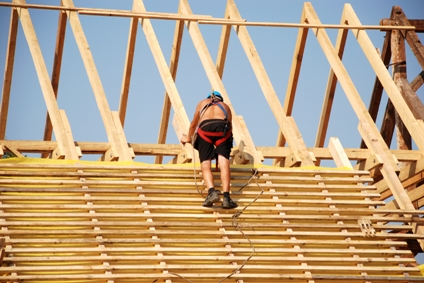
Fall Protection
Dear Working Wise:
I visit construction sites all around Alberta as part of my job and I am constantly amazed to see roofers and framers working high up with no safety lines. Aren’t they supposed to be tied off or something? Signed – Concerned Contractor.
Dear Concerned:
Yes, anyone working at a height of three metres or more is required to use fall protection.
Falls, from any height, are a common cause of serious injury and even death in the workplace. In fact, of the 23 workplace incidents that have been reported to Alberta Occupational Health and Safety this year (since January 1, 2010), eight involved falls.
The following story illustrates why everyone should use fall protection.
A roofer and his helper were installing shingles on a two-storey house. The roofer only had one harness and so he made his helper wear it. The roofer tripped and fell into his helper – causing them both to fall from the roof. The roofer fell eight metres and sustained serious injuries. His helper was bruised but walked away from the fall.
Workers can wear a full body harness attached to an anchor point. They can also be protected with guardrails or some other restraint system that would prevent them from getting too close to the edge.
Section 139 of Alberta's Occupational Health and Safety Code states that fall protection is necessary when "the worker may fall three metres or more," or when "there is an unusual possibility of injury if a worker falls less than three metres."
For example, fall protection is necessary if the worker could land on something other than a solid, flat surface, like uncapped rebar or other construction materials.
The three-metre fall distance is measured from the point from which a worker may fall, from their feet to the lower level. The vertical height that a worker may roll or slide down the sloped roof before they lose contact with the roof is not considered to be part of the "fall distance." If the worker is working close to the gable end of a roof (in residential construction) then that height is included.
If you come across a worksite where workers are up high and clearly not protected, you can call Workplace Health and Safety at 1-866-415-8690. They will send an occupational health and safety officer to check out the scene.
The Alberta Construction Safety Association has a set of guidelines to help workers minimize the risks associated with the use of fall protection equipment. Here are some of ACSA's precautions for individual workers:
· Know the capabilities of the fall protection equipment.
· Ensure the safety line is the right length for the height and it fits properly.
· Know the anchor points on the building.
· Do not wrap the lanyards or rope around beams, girders, or pipes.
· Use the buddy system. Workers should check each other's harness and lines.
It is the employer's responsibility to ensure that their workers are protected as much as possible. That includes having the proper equipment on site and ensuring that all employees are trained in its use. Employers should ensure that only competent trained workers are up on the roof or other structure.
Unfortunately, complacency happens. Workers forget, get too busy or in some cases, don't bother using their safety equipment. For the unlucky ones, their complacency catches up with them and that's when injuries happen.
For more information on fall protection or any other workplace health and safety issues, go to www.employment.alberta.ca/whs or worksafely.org.
Do you have a work-related question? Send your questions to Working Wise, at charles.strachey@gov.ab.ca. Charles Strachey is a regional manager with Alberta Employment and Immigration. This column is provided for general information.
















